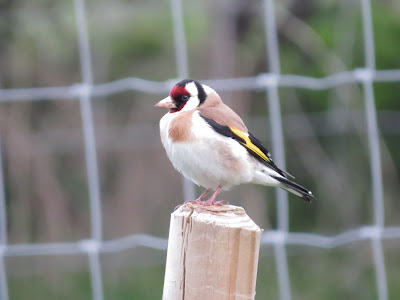I completed another plantation woodland bird survey in Cumbria yesterday morning, and this time it was in the northeast of the county in the Eden valley. This particular site is one of my favourites and usually produces some half decent results.
At first light, which is getting a tad early now I have to say, I had five oktas cloud cover with a cold 10 mph northerly wind. I had three small blocks of plantation woodland to survey raging from recently planted to woodland planted about eight years ago. For ease I'll just give a list as follows of the more interesting species that I recorded; eight
Willow Warblers, five
Redstarts (four males & a female), a
Mistle Thrush, eleven
Shelducks, four
Tree Sparrows, a
Siskin, a
Stock Dove, a
Sedge Warbler, a
Yellow Wagtail, a
Song Thrush, a pair of
Bullfinches, a
Blackcap, three
Coal Tits and a
Buzzard.
Adjacent to one block of plantation woodland that I was surveying was an existing small area of woodland and in a dead Ash tree a pair of Redstarts were prospecting a potential nest site. The male kept going in to the hole and then singing from the entrance to the cavity, and the female would come over and have a a look. On two occasions whilst the male was in the hole a
Blue and
Great Tit went in to the hole and the male Redstart chased them out. Then another male Redstart came over and the two males were chasing each other around the trees and only a few feet from me; stunning!
Redstart
Breeding waders were the target for my work this morning in Bowland. I was surveying one of my client's farms and checking that the habitat creation/restoration that he has undertaken is proving attractive to breeding waders. The main aim is to improve the habitat for
Curlew and
Lapwing, and if we can attract any other species that would be a bonus. I checked the eight fields where he has created scrapes, specifically manages the sward height and manages the amount of rush cover and found five pairs of
Oystercatchers, 17 pairs of Lapwings, a pair of
Snipes and seven pairs of Curlew.
One of the Lapwing chicks that I ringed.
Of course I was seeing other species on my walk round and I had at least four singing Willow Warblers and five
Lesser Redpolls. One pair of Lesser Redpolls were displaying close to me whilst I got all of my gear together before setting off.
Over the fell at the back of one of the wader fields I had a Buzzard and a
Peregrine, and later three
Ravens. One of my best sightings was a male
Cuckoo. I heard Lapwings and
Meadow Pipits alarm calling and the Cuckoo flew over the hedge and landed in a tree adjacent to the stream. I could see him well with my bins, but sadly he was just a little distant for a photograph. I then saw a flash of red and a male Redstart dived into the hedge and shortly afterwards a female
Wheatear bobbed along a stone wall.
The fell at the back.
It was a pleasant morning's work and tomorrow I was supposed to do another survey in the north Pennines but unfortunately it is going to be a bit too windy. It does mean that I can have a beer tonight and I won't be too tired when I go to see Genesis six string wizard Steve Hackett tomorrow evening!




















